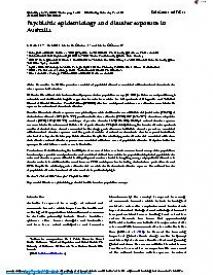Psychiatric epidemiology and disaster exposure in Australia
To examine the lifetime prevalence and risk of psychiatric disorders associated with natural and man-made disaster exposure in Australia.
Methods.
We utilised data from a nationally representative population survey (N = 8841) which were analysed through univariate and multivariate logistic regression in order to examine the full spectrum of Diagnostic and Statistical Manual of Mental Disorders, Fourth Edition (DSM-IV) affective, anxiety and substance use disorders associated with exposure to natural and man-made disaster.
Results.
Man-made disaster exposure was primarily associated with an increased lifetime risk (odds ratio (95% CI)) of alcohol abuse disorder 2.29 (1.56–3.37), post-traumatic stress disorder (PTSD) 2.27 (1.36–3.79), obsessive–compulsive disorder (OCD) 1.95 (1.08–3.51) and major depressive disorder 1.69 (1.01–2.85). Multiple natural disaster exposure was associated with an increased lifetime risk of panic disorder 2.26 (1.11–4.61). Among the broader disorder spectrum examined, alcohol abuse disorder accounted for the single greatest increase in lifetime disorder prevalence associated with man-made disaster exposure, and the greatest number of natural or man-made disaster exposed individuals who had developed a lifetime psychiatric disorder. Despite the relatively greater disorder risk associated with man-made disaster, natural disaster exposure was associated with more cases of psychiatric disorder, likely due to the frequency with which these events occur in Australia.
Conclusions.
Notwithstanding the inability to draw causal inferences from cross-sectional survey data, population-based analyses provide a comprehensive and consistent method to ascertain the population imprint of psychiatric disorder and disaster exposure. Mental health policy and services should be targeting a range of psychiatric disorders in disaster contexts in addition to the usual focus on PTSD and depression, including alcohol abuse, panic disorder and OCD. Despite the relatively greater disorder risk associated with man-made disaster exposure, the national burden of psychiatric disorder in natural disaster contexts is particularly high.
Geachte bezoeker,
De informatie die u nu opvraagt, kan door psychotraumanet niet aan u worden getoond. Dit kan verschillende redenen hebben,
waarvan (bescherming van het) auteursrecht de meeste voorkomende is. Wanneer het mogelijk is om u door te verwijzen naar de bron
van deze informatie, dan ziet u hier onder een link naar die plek.
Als er geen link staat, kunt u contact opnemen met de bibliotheek,
die u verder op weg kan helpen.
Met vriendelijke groet,
Het psychotraumanet-team.
In: Epidemiology and Psychiatric Sciences, ISSN 2045-7960 ; eISSN 2045-7979 | 28 | 3 | 310-320
https://doi.org/10.1017/S2045796017000531


